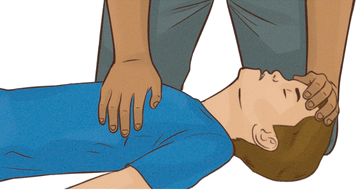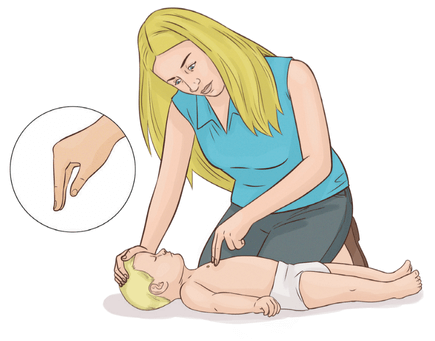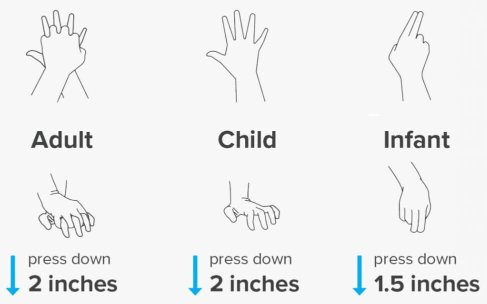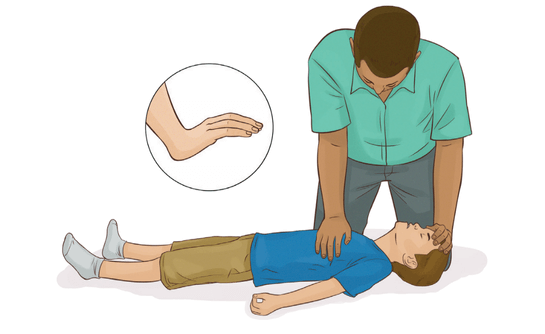4.2 C – Chest Compressions (Infants & Children)
Compression Rate and Ratio
The recommended compression rate for all age groups—including infants, children, and adults—is 100 to 120 compressions per minute.
The compression-to-ventilation ratio for a single rescuer is 30:2 across all ages. For two-rescuer CPR in infants and children, the ratio changes to 15:2.
Compression Reference Table
| Aspect | Child | Infant |
|---|---|---|
| Compression Rate | 100–120 per minute | 100–120 per minute |
| Compression Depth | At least 1/3 chest depth (~2 in / 5 cm) | At least 1/3 chest depth (~1.5 in / 4 cm) |
| Hand/Finger Placement |
1 or 2 hands on lower half of sternum
×
1 or 2 hands on lower half of sternum

© FAW Training Solutions – All rights reserved
|
2 fingers just below nipple line
×
2 fingers just below nipple line

© FAW Training Solutions – All rights reserved
|
| Single Rescuer Ratio | 30:2 (compressions to breaths) | 30:2 (compressions to breaths) |
| Two-Rescuer Ratio | 15:2 | 15:2 |
| Surface | Firm, flat surface | Firm, flat surface |
| Key Technique Tip | Use one hand for small children; keep fingers off ribs | Avoid pressure on xiphoid process |
Child Chest Compression Technique
×
Child Chest Compression Technique
 © FAW Training Solutions – All rights reserved
© FAW Training Solutions – All rights reserved
×

Child Chest Compression Technique

© FAW Training Solutions – All rights reserved
For most children, chest compressions are performed using two hands, just like in adult CPR. For smaller children, compressions can be performed using only one hand as long as the depth reaches at least 1/3 the chest diameter (approximately 2 inches or 5 cm).
Child Chest Compressions
×
Child Chest Compressions
 © FAW Training Solutions – All rights reserved
© FAW Training Solutions – All rights reserved
×

Child Chest Compressions

© FAW Training Solutions – All rights reserved
- Ensure the child is on a firm, flat surface, face up. Move only if necessary or unsafe.
- Position yourself correctly: Stand or kneel at the child's side.
- Hand placement and body positioning:
- Place the heel of one hand in the center of the child’s chest on the lower half of the sternum.
- For larger children, use two hands with interlocked fingers (as with adults).
- Keep fingers off the ribs and your arms straight, with shoulders directly over your hands.
- Begin compressions:
- Compress at a rate of 100–120 per minute.
- Compress the chest at least 1/3 its depth (~2 inches or 5 cm).
- Allow the chest to fully recoil after each compression.
Infant Chest Compressions
×
Infant Chest Compressions
 © FAW Training Solutions – All rights reserved
© FAW Training Solutions – All rights reserved
×

Infant Chest Compressions

© FAW Training Solutions – All rights reserved
- Ensure the infant is on a firm, flat surface, face up. Move only if necessary or unsafe.
- Hand placement:
- Place two fingers in the center of the infant’s chest, just below the nipple line.
- Avoid pressing on the tip of the sternum (xiphoid process).
- Begin compressions:
- Compress at a rate of 100–120 per minute.
- Compress to a depth of 1/3 of the chest diameter (~1.5 inches or 4 cm).
- Allow full chest recoil after each compression.
- After 30 compressions (single rescuer):
- Open the airway using a head tilt–chin lift.
- Deliver 2 rescue breaths with visible chest rise.
- After 5 cycles (~2 minutes):
- Activate the Emergency Response System (ERS) and retrieve an AED.
- Continue CPR until EMS arrives or the infant shows signs of life.
Important: Avoid interrupting compressions unless absolutely necessary. Do not move the victim unless they are in immediate danger or on an unstable surface (e.g., bed or couch).